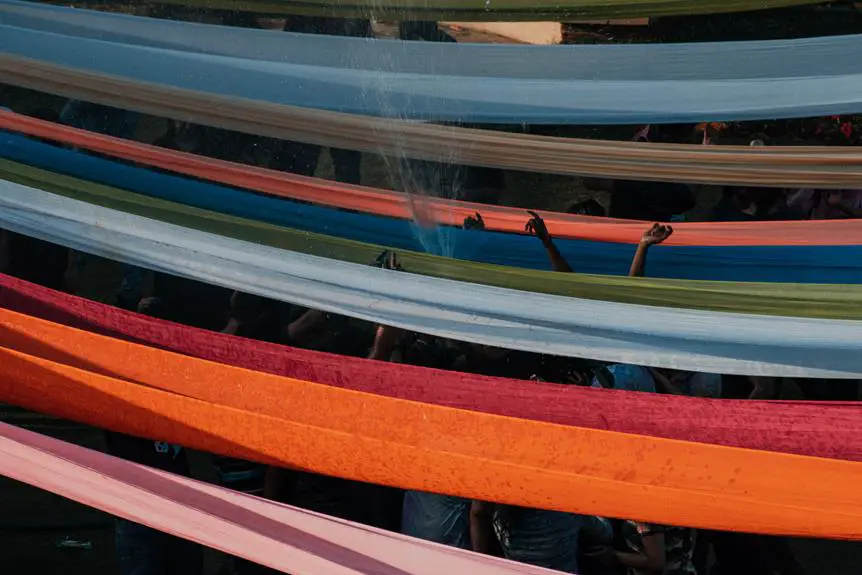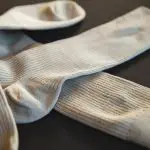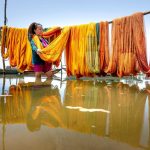Looking for fabrics that can keep you dry in wet conditions? Let's explore which fabrics are water resistant.
From cotton to Gore-Tex, various materials offer different levels of protection against moisture. Understanding their properties will help you select the ideal fabric for your needs.
Whether it's for outdoor activities or everyday wear, knowing which fabrics repel water will give you the advantage of staying comfortable and dry.
Key Takeaways
- Cotton is less effective in repelling water compared to synthetic materials.
- Polyester is known for its water-repellent properties and keeps the wearer dry and comfortable.
- Nylon has excellent water-repelling properties and its tight weave reduces water permeation.
- Wool has a natural water-repellent structure, can wick away moisture, and remains breathable.
Cotton and Water Resistance
When you're considering water resistance, cotton is a fabric that you may find less effective in repelling water compared to synthetic materials. This is due to cotton's moisture absorption capabilities. Cotton has a tendency to retain water, which can make it feel heavy and damp when exposed to moisture.
Additionally, cotton's breathability characteristics, while favorable in some contexts, can also contribute to its lack of water resistance. The ability of cotton to allow air to pass through also means that it allows water to penetrate more easily compared to synthetic fabrics that have a tighter weave or are treated with water-repelling finishes.
Understanding these properties of cotton is essential when evaluating its suitability for specific uses, particularly in environments where exposure to water is a concern. While cotton may not be the best choice for water-resistant clothing or gear, its breathability and moisture absorption can make it a comfortable option in dry or low-moisture settings.
It's important to consider the intended purpose and environmental conditions when choosing fabrics for water resistance.
Polyester and Water Resistance
Polyester is known for its water-repellent properties, making it a popular choice for water-resistant clothing and outdoor gear. Understanding how to enhance polyester's water resistance can help you make the most of its capabilities, ensuring that you stay dry and comfortable in various weather conditions.
Additionally, proper care and maintenance are crucial for preserving the water-resistant qualities of polyester fabrics.
Polyester's Water Repellency
To ensure water repellency, consider choosing polyester for its effective resistance to moisture. Polyester is a synthetic fabric known for its water-repelling properties. It is widely used in outdoor and athletic apparel due to its ability to keep the wearer dry and comfortable. The molecular structure of polyester makes it inherently water-resistant, making it an ideal choice for various weather conditions. Additionally, it is often combined with other materials to enhance its water-repelling capabilities. The following table summarizes the water resistance properties of polyester compared to microfiber and breathable fabrics:
| Fabric Type | Water Resistance Level | Breathability |
|---|---|---|
| Polyester | High | Moderate |
| Microfiber | Low | High |
| Breathable Fabrics | Moderate | High |
Polyester stands out for its high water resistance level, making it a reliable choice for outdoor and water-related activities.
Enhancing Polyester's Resistance
Polyester treatments and waterproofing techniques can enhance its resistance to water. One common method is applying a durable water repellent (DWR) finish to the fabric, which creates a hydrophobic surface, causing water to bead up and roll off instead of being absorbed. This treatment doesn't affect the fabric's breathability but significantly improves its ability to repel water.
Another technique involves incorporating waterproof membranes or coatings into the fabric during the manufacturing process. These membranes create a barrier that prevents water from penetrating the fabric while still allowing moisture to escape.
Additionally, using special detergents specifically designed for waterproof fabrics can help maintain and restore the water resistance of polyester garments.
Caring for Water-Resistant Polyester
To maintain the water resistance of your polyester fabric, you should follow specific care instructions recommended for water-resistant materials. Here are some essential tips for caring for your water-resistant polyester:
- Stain Protection: Apply a fluorocarbon-based spray-on treatment to enhance the fabric's ability to repel water and resist stains.
- Fabric Maintenance: Regularly clean your water-resistant polyester using a gentle detergent and avoid using fabric softeners, as they can compromise the fabric's water resistance.
- Avoid High Heat: When washing and drying your water-resistant polyester, use low temperatures to prevent damaging the fabric's water-repellent properties.
- Reapply DWR (Durable Water Repellent): Over time, the DWR coating on your polyester fabric will wear off, so it's essential to reapply it periodically to maintain its water-resistant capabilities.
Nylon and Water Resistance
When choosing a water-resistant fabric, consider nylon for its excellent water-repelling properties. Nylon is renowned for its durability, making it a popular choice for outdoor gear such as raincoats, tents, and backpacks. The durability of nylon makes it an ideal option for withstanding the wear and tear of outdoor activities while providing reliable water resistance.
Nylon's water resistance can be attributed to various waterproofing techniques such as coating the fabric with polyurethane or silicone. These techniques create a barrier that prevents water from permeating the material. Additionally, the tight weave of nylon fabric also contributes to its water-resistant nature, as it reduces the likelihood of water penetration.
In addition to its water resistance, nylon is a lightweight and breathable fabric, adding to its appeal for outdoor and athletic wear. Its versatility and ability to maintain its water-resistant properties over time make it a sought-after choice for various applications.
Wool and Water Resistance
When seeking water-resistant fabrics, wool stands out as a natural option effective in repelling moisture. Wool possesses inherent properties that make it water-resistant. Here's why wool is an excellent choice for water resistance:
- Natural Water Repellency: The structure of wool fibers makes them naturally water repellent. The outer layer of the wool fiber consists of overlapping scales, which prevent water from easily penetrating the fabric.
- Moisture Wicking: Wool has the ability to wick away moisture, keeping you dry even when it's wet outside. This is due to the hygroscopic nature of wool, allowing it to absorb moisture vapor and then slowly release it into the environment.
- Innovative Treatments: Advancements in technology have led to the development of water repellent wool technology. Special treatments can be applied to wool fabrics to enhance their water resistance without compromising the natural properties of wool.
- Breathability: Despite being water-resistant, wool remains breathable, allowing for moisture vapor to escape, which helps in maintaining comfort.
These properties and technologies make wool an excellent choice for those seeking water-resistant fabrics with natural and effective moisture repellency.
Gore-Tex and Water Resistance
Gore-Tex is a highly sought-after fabric due to its impressive water resistance technology. Understanding how Gore-Tex works and its water-resistant properties can help you make informed decisions when choosing outdoor gear.
Let's delve into the technology behind Gore-Tex and the benefits it offers for water resistance.
Gore-Tex Technology Explained
For high-performance water resistance, consider exploring the technology behind Gore-Tex. Gore-Tex is designed to provide exceptional waterproofing and breathability, making it a top choice for outdoor enthusiasts. Here's what you need to know about Gore-Tex technology:
- Microporous Membrane: Gore-Tex features a microporous membrane that has over 9 billion pores per square inch, allowing sweat vapor to escape while preventing water from entering.
- Durable Water Repellent (DWR) Finish: The DWR finish on Gore-Tex fabric helps water bead up and roll off, maintaining the fabric's breathability and water resistance over time.
- Guaranteed to Keep You Dry Promise: Gore-Tex products are rigorously tested to ensure durability and long-lasting waterproofness, backed by the 'Guaranteed to Keep You Dry' promise.
- Balanced Waterproofness and Breathability: Gore-Tex strikes a balance between waterproofness and breathability, making it ideal for various outdoor activities.
Water Resistance in Gore-Tex
To understand the water resistance of Gore-Tex, it's essential to recognize the technology's innovative approach to balancing waterproofness and breathability.
Gore-Tex is famous for its ability to provide both waterproof and breathable properties. This is achieved through a microporous membrane that's impermeable to liquid water while allowing water vapor to pass through, ensuring that you stay dry from the outside elements and from perspiration.
The key to Gore-Tex's water resistance lies in this balance between being waterproof and breathable. Additionally, Gore-Tex is designed to offer durability without compromising flexibility. This means that the fabric can withstand harsh conditions while allowing you to move comfortably.
Understanding the intricate balance between waterproofness and breathability, as well as durability and flexibility, is crucial in appreciating the water resistance of Gore-Tex.
Benefits of Gore-Tex
Achieving a delicate balance between waterproofness and breathability is essential for understanding the benefits of Gore-Tex in providing water resistance. Gore-Tex technology offers numerous advantages, making it a preferred choice for outdoor enthusiasts and professionals seeking reliable protection from the elements.
Here are the key benefits of Gore-Tex:
- Waterproofness: Gore-Tex provides exceptional water resistance, keeping you dry even in the harshest conditions.
- Breathability: This technology allows moisture vapor to escape, ensuring comfort during physical activities.
- Durability: Gore-Tex is highly durable, maintaining its water-resistant properties even after prolonged use.
- Comfort: Its breathability and waterproofness work together to provide all-day comfort, making it ideal for various outdoor activities.
With these benefits, Gore-Tex stands as a proven choice for those seeking top-tier water-resistant performance.
Polyurethane and Water Resistance
You can improve the water resistance of fabrics by adding a thin layer of polyurethane coating. Polyurethane fabric coatings enhance water resistance, providing durability and protection against the elements. By creating a barrier on the fabric surface, polyurethane prevents water from penetrating while maintaining breathability and performance.
This coating is particularly beneficial for outdoor gear, such as rain jackets, tents, and backpacks, as it significantly enhances the fabric's ability to repel water. The durability of polyurethane-coated fabrics also ensures that the water resistance remains effective over an extended period.
Additionally, the flexibility of polyurethane allows for comfortable movement without compromising the fabric's ability to keep you dry. When selecting water-resistant fabrics, considering the presence of polyurethane coatings can significantly impact the overall performance and longevity of the product.
Therefore, understanding the role of polyurethane in enhancing water resistance is essential for individuals seeking high-quality, durable fabrics that effectively repel water while maintaining breathability and comfort.
Wax-Coated Fabrics and Water Resistance
An alternative method for enhancing water resistance in fabrics is through the application of a wax coating. Wax-coated fabrics offer exceptional durability, making them ideal for outdoor activities where water resistance is crucial. Additionally, they've become increasingly popular in fashion trends due to their ability to repel water while maintaining a stylish appearance.
Here are some key points to consider about wax-coated fabrics and their water resistance:
- Durability: Wax-coated fabrics are known for their robustness, allowing them to withstand harsh weather conditions and frequent use without compromising their water-resistant properties.
- Maintenance: Proper maintenance is essential to preserve the water resistance of wax-coated fabrics. Regular reapplication of wax and gentle cleaning can help prolong their effectiveness.
- Outdoor Activities: Whether you're hiking, camping, or engaging in other outdoor pursuits, wax-coated fabrics are an excellent choice for staying dry and comfortable in wet conditions.
- Fashion Trends: From jackets to bags, wax-coated fabrics have made their mark in the fashion industry, offering both style and practical water resistance for everyday use.
Blends and Water Resistance
When selecting water-resistant fabrics, consider blending materials to enhance their protective properties against moisture. Fabric blends can improve durability and water resistance, making them a sustainable choice for various applications.
By combining natural and synthetic fibers, you can create fabrics that offer both strength and water repellency. For example, mixing polyester with cotton can result in a fabric that's more water-resistant than pure cotton, while still maintaining breathability and comfort. Additionally, blending wool with synthetic fibers can increase the fabric's durability and water resistance, making it suitable for outdoor wear or protective gear.
Blending materials also allows for the incorporation of eco-friendly options, contributing to sustainability. By combining organic cotton with recycled polyester, you can create a water-resistant fabric that's both durable and environmentally conscious. This approach aligns with the growing demand for sustainable products in the textile industry.
Frequently Asked Questions
Are There Any Special Care Instructions for Maintaining the Water Resistance of Cotton, Polyester, Nylon, Wool, Gore-Tex, Polyurethane, Wax-Coated Fabrics, and Blends?
To maintain water resistance in fabrics like cotton, polyester, nylon, wool, gore-tex, polyurethane, and wax-coated blends, follow special care instructions. Regularly apply protective treatments and avoid harsh cleaning methods to preserve breathability.
Can Water Resistance Be Added to Fabrics That Are Not Naturally Water Resistant, Such as Cotton or Wool?
You can waterproof fabrics like cotton or wool through various techniques. Synthetic fabrics are easier to waterproof, but natural fabrics can also be treated with waterproofing sprays, waxes, or coatings for added water resistance.
How Long Does the Water Resistance Last in Fabrics Like Polyester, Nylon, and Gore-Tex? Do They Need to Be Re-Treated Over Time?
Water resistance in fabrics like polyester, nylon, and gore-tex can last for a significant period, varying based on usage and care. Over time, they may require re-treatment to maintain optimal water resistance, ensuring prolonged effectiveness.
Are There Specific Activities or Environments Where Certain Water-Resistant Fabrics Are More Effective Than Others?
In certain activities or environments, water-resistant fabrics like Gore-Tex are more effective due to their durability and breathability. Specific care instructions for fabric blends with added treatment may vary, requiring periodic re-treatment for continued effectiveness.
Can Water Resistance in Fabrics Affect Their Breathability or Comfort?
Balancing water resistance and breathability is crucial for comfort in water-resistant fabrics. When these properties are in harmony, you can stay dry without feeling stifled. Understanding how different fabrics achieve this balance is key.
- How Does Ring Spun Cotton Affect Garment Fit and Shape Retention? - August 13, 2024
- What Are the Challenges in Producing Ring Spun Cotton? - August 13, 2024
- Is Ring Spun Cotton Suitable for Plus-Size Clothing? - August 13, 2024







